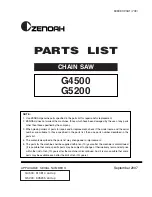
4
EN
G
LI
SH
General safety rules
• Never use the saw when you are tired, sick, under the influence of alcohol or medicine.
• Local regulations may restrict the age of the operator; check what minimum operator age requirements apply to your region.
• Always be careful when handling fuel. Wipe off any spilt fuel and move the saw at least 3 metres away from the refuelling
location before starting it.
• Remove any sources of ignition and see that there are no sparks, naked flames, lit cigarettes, etc. in the area where
the fuel is mixed, used or stored.
• Never smoke when refuelling or operating the saw.
• Do not permit anyone other than the operator to come close to the saw when it is being started or used. Children, pets
and onlookers should be kept at least 10 metres away from the saw when it is being started or used.
• Never begin using the saw without having full view of the entire work area. Keep your proper footing and balance and
make sure that you have a planned retreat path to a safe place away from the falling tree.
• Never work alone, always have a person close by whom you can call if you need help.
• Never work in poor light conditions, heavy rain or strong wind.
• The saw must only be used for cutting natural untreated wood.
• Never use the chainsaw on treated wood.
• The saw must not be used for clearing brush.
• Make sure that the saw chain is not in contact with any object before starting.
• Always carry the chainsaw with the engine shut off, the guide bar to the rear and the silencer pointing away from the body.
• Always inspect the saw before starting it. Do not start it if there are worn, missing or damaged parts. Never use the saw
if it is damaged, incorrectly adjusted or incorrectly assembled. When the engine has started: Check that the chain saw
stops completely when you let go of the throttle.
• Any service of the saw other than that mentioned in this instruction manual should be carried out by qualified service personnel.
• Always shut off the engine before placing the saw on the ground.
• Use extreme caution when cutting brush and saplings because slender material may fasten in the saw chain and be
whipped towards you or pull you off balance. Be careful when cutting limbs under tension. Guard against falling branches
and be alert for springback and pinching of the guide bar when the tension in the fibres of the wood is released.
• Keep the handles dry, clean and free of oil and fuel mixture.
• Operate the chainsaw only in well-ventilated areas.
• Never operate the saw in a tree unless you have been specially trained for such work.
• Never transport the saw without the scabbard fitted.
• Never operate the saw close to flammable liquids or gases, doing so poses a risk of fire or explosion.
• Never refuel, top up the oil or perform any maintenance to the saw when the engine is running.
• First-time users should be equipped with safety equipment and be instructed in the correct use of the chainsaw by
an experienced operator.
• Never start the saw indoors. The saw will emit poisonous exhaust gases as soon as it is started, these gases may be
invisible and odourless but are harmful if inhaled. Be aware that the saw will produce harmful sawdust and oil mist from
chain lubrication, protect yourself accordingly.
• Always wear gloves and keep your hands warm when using the product. Long-term exposure to hand-arm vibration from
using a chainsaw can lead to permanent damage to hands and arms. If you experience symptoms such as poor blood
circulation, white finger tips, reduction in sense of touch, numbness or tingling in fingers, contact a doctor.
• Drive in the spiked bumper directly behind the intended cut and let this be the hinge around which the saw pivots.
Safety symbols
Make sure that you have read and understood the entire instruction manual before starting to use the product.
Wear an approved helmet, approved ear defenders and safety glasses/visor.
Improper use can cause injury and damage to the product.
Warning:
Risk of kickback.





































